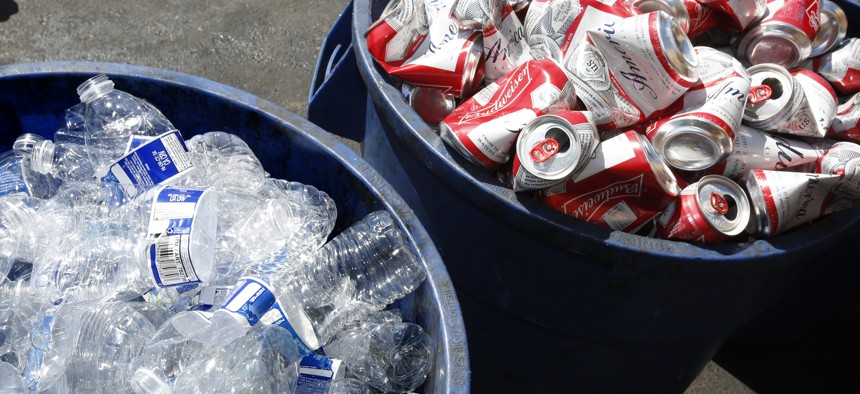Recycling Labels Don’t Reflect Reality for Local Governments

In this July 5, 2016, file photo, cans and plastic bottles brought in for recycling are seen at a recycling center in Sacramento, Calif. AP Photo/Rich Pedroncelli
A local government official says the federal government could help by setting standards that make clear what plastics are recyclable.
Red solo cups and plastic takeout containers may have recycling symbols printed on the bottom, but that doesn’t mean most municipal recycling programs accept them. Instead, those items more often contaminate the pile of plastic refuse collected and make it more difficult for municipalities to recycle, a county environmental director told congressional lawmakers on Wednesday.
That’s why “truth in recycling” labels or federal guidance on which types of plastics are recyclable would be helpful for local governments, said Adam Ortiz, the director of Montgomery County, Maryland’s Department of Environmental Protection.
Addressing a subcommittee of the House Appropriations Committee, Ortiz held up one such example, a plastic food container made of plastic #6, a class of polystyrene plastics that include Styrofoam. While the container has a recycling symbol, Ortiz said his own county does not recycle such items, nor do many other local governments.
“To most consumers, they are going to look at that and think it’s recycling. But once they put that in the recycling bin, that becomes an internalized cost and a burden for all of us,” he testified.
He suggested that materials should be required to meet a threshold for recyclability at the municipal level before earning the right to use the triangular recycling symbol.
“That would remove a lot of the contamination, a lot of the burden we’re picking up,” Ortiz said.
Local leaders have increasingly questioned whether their municipalities can continue to absorb the rising costs to recycle plastics, paper and glass since China stopped accepting most foreign recyclables in 2017.
The Environmental Protection Agency doesn’t have regulatory authority over the hundreds of recycling programs that state and local governments run to help dispose of their waste. But noting that municipal recycling standards “are highly variable” across the country, the agency is trying to encourage local governments to get on the same page, EPA Assistant Administrator Peter Wright told the committee.
The EPA released a national framework to improve recycling in November. As part of that initiative, the agency plans to announce proposed national recycling goals in May and accept public comment in the following months, Wright said.
“We want to create clear messages that can be used to educate consumers on what can and can’t be recycled,” he said.
Americans discard more than $9 billion worth of materials each year that could be recycled.
While some cities have begun to ban plastic bags, straws and other single-use plastics— items that often contaminate the recycling stream—approximately 15% of materials that cities collect at municipal recycling facilities are considered contamination, said Michael Gajewski, the managing director of Closed Loop Partners, an investment firm specializing in recycling and sustainability.
Several innovations, including robotics and artificial intelligence that can help stop contamination, could drive increased recycling potential in the coming year, Gajewski said.
Industry-led efforts to design product packaging that is more profitable for the recycling industry could also encourage higher rates of recycling. Advancements in chemical recycling, which allows materials that are degradable over time to be removed from certain plastics, could also make the materials more desirable, he said.
Ortiz said that Montgomery County loses money on recycling materials like glass, but continues to do so anyway to provide the service to residents. But for other jurisdictions, recycling programs are just too expensive to sustain.
Daniel Corona, mayor of West Wendover, Nevada, told lawmakers that for many small and rural jurisdictions like his, it is difficult to sustain a recycling program that doesn’t pay for itself.
West Wendover cut its recycling program in 2012 due to costs. Restarting it would be a major financial barrier, costing upwards of $1 million, Corona said. Contracting with recycling companies would also be expensive because the city would have to pay a premium to have recyclables transported to the closest processing facility, located more than 100 miles away.
“Even if this was a feasible option for our community, it would remain difficult to find a partner in the current market environment,” Corona said.
Andrea Noble is a staff correspondent with Route Fifty.

NEXT STORY: Thy Neighbor’s Solar Panels





